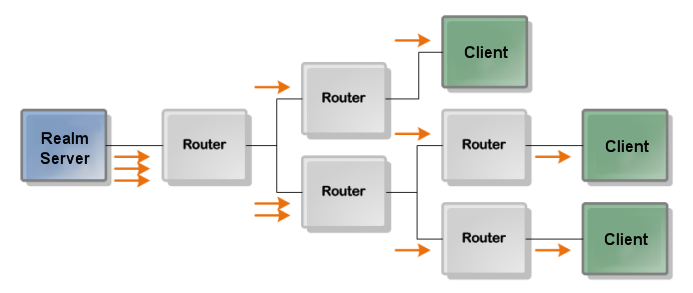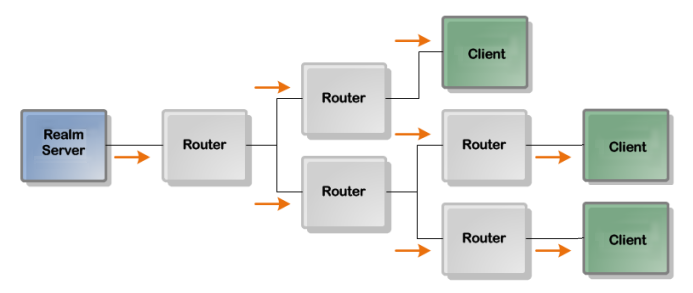Multicast: An Overview
Universal Messaging's ability to provide 'ultra-low latency' messaging has been further developed with the introduction of multicast options in addition to unicast to distribute messages to client applications.
With unicast, the server must physically write the message once for each destination client:
 Figure 1: Universal Messaging in Unicast Mode
Figure 1: Universal Messaging in Unicast ModeWith multicast, a message is written to the network once where it is then routed to all connections in that multicast group:
 Figure 2: Universal Messaging in Multicast Mode
Figure 2: Universal Messaging in Multicast ModeMulticast has clear performance improvements in terms of scalability. Where the performance of unicast gradually degrades as the number of destinations increases, multicast performance does not as the server still only has to write a message once per destination.
Universal Messaging supports multicast for cluster communication and can be enabled on individual DataGroups. Universal Messaging will then transparently operate in a multicast delivery mode for clients on networks capable of supporting the multicast protocol else continue to use unicast.
When you create a DataGroup you can pass a flag to enable multicast delivery. The Universal Messaging realm will automatically begin delivering events published to that group via multicast. When a client DataStream is added to a multicast enabled Data Group, it will transparently receive the information it needs to begin consuming via multicast. Multicast delivery may not be possible for all clients so initially the client will be sent events via both unicast and multicast. The user will only be delivered the data once however.
The Universal Messaging server will quickly detect whether or not the multicast packets are reaching the client as it does or does not receive acknowledgements. If the client does not support multicast, the server will simply continue to send events to that client via unicast. If the multicast packets do reach the client then after a period of time when both unicast and multicast are in sync, the Universal Messaging Server will stop sending unicast events to that DataStream.
Multicast addresses packets using the User Datagram Protocol (UDP) as opposed to TCP which is used in unicast. UDP is a connectionless protocol and does therefore not guarantee delivery or packet ordering in way that TCP does. However Universal Messaging still provides these guarantees by implementing the required checks at the application layer. These checks happen completely transparently to the user and any packet retransmissions can be monitored using the nAdminAPI or the Enterprise Manager.
 Figure 1: Universal Messaging in Unicast Mode
Figure 1: Universal Messaging in Unicast Mode Figure 1: Universal Messaging in Unicast Mode
Figure 1: Universal Messaging in Unicast Mode Figure 2: Universal Messaging in Multicast Mode
Figure 2: Universal Messaging in Multicast Mode